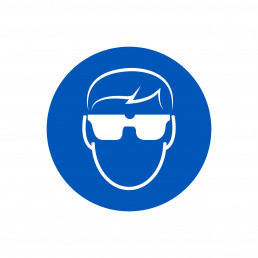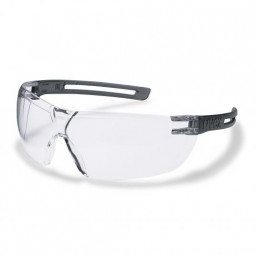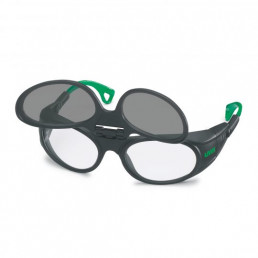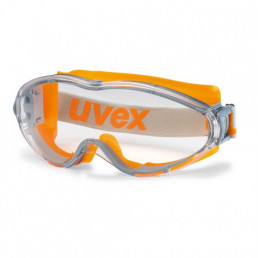In many situations, it seems logical to wear safety spectacles. But when is it actually compulsory? And where are the hidden dangers? We take a look at these questions in the following blog post. We will also clear up anything else you need to bear in mind when it comes to protecting your eyes.
When is it compulsory to wear safety spectacles?
In many workplace environments, you are exposed to hazards that could damage your eyes. Your employer must verify whether this is the case in your workplace. They will carry out a risk assessment to examine these hazards with respect to type, scope, duration of contact and the probability that they will cause damage to the eye and facial area. They will also determine whether these hazards can be limited in any other way – for example, by making organizational changes to workflows or installing protective equipment (protective glass, covers etc.).
The following sign indicates that it is compulsory to wear safety spectacles in a workplace environment:

What safety hazards are classified as dangerous?
Mechanical, optical, chemical, thermal, biological and electrical sources can pose a danger to the eye and facial area.
- Mechanical hazards:
This is where foreign bodies get into the eye, which can lead to injuries to the cornea. These include dust, splinters from various materials, wood and metal shavings etc.
Workplace environments: welding, forestry work, woodwork, factories
- Optical hazards:
Optical hazards include all types of light irradiation. The danger to a person’s eyesight increases according to the intensity of the light. A distinction is made here between ultraviolet radiation, visible radiation, infrared radiation and lasers.
Workplace environments: welding, laser treatment, working under black light/LED light
- Chemical hazards:
When chemicals get into the eye, this can lead to permanent damage. Chemical hazards include vapours, smoke, acids and other solid, liquid and gaseous substances.
Workplace environments: laboratories, fire brigade
- Thermal hazards:
Thermal hazards manifest themselves through dryness or frostbite symptoms on the cornea. This happens when liquid gases, infrared radiation or too much cold acts upon the eye.
Workplace environments: refrigerated warehouses, working in cold weather conditions, fire brigade
- Biological hazards:
These include bacteria, viruses, fungi and spores.
Workplace environments: laboratories, hospitals, disease control, gardeners
- Electrical hazards:
Electric arcs may be produced during a short circuit, discharging particles at extremely high temperatures which can land in the eyes or face.
Workplace environments: electronic engineers, industrial electricians
If an employer assesses these hazards as dangerous to the eye and facial area, they are obliged to inform employees of their duty to wear safety spectacles and provide them with the necessary safety spectacles.
Depending on the type of hazard, the employer must also decide what type of eye protection is to be worn in which area.
Which safety spectacles are the right ones for me?
We distinguish between three types of safety spectacles:
Spectacles

Spectacles are available with or without UV protection. Our spectacles with UV400 protection are the ideal choice if you are exposed to optical hazards. They are also chemical-resistant, making them suitable for workplace environments exposed to chemical hazards. Our spectacles are also extremely scratch-resistant, meaning they remain free from scratches and ensure optimum vision even when exposed to flying splinters.
Take a look at our range of spectacles:
Welding shade

Our welding shades are available in different welding protection levels – from level 1 to 6. Thanks to the large panoramic lens and uvex sunglare filter with perfect colour recognition, you have a clear and perfect view while welding. The new filter technology also combines UV and IR radiation protection. In addition, the practical uvex infradur coating makes our welding shades extremely scratch-resistant on both sides, hugely minimising damage from welding sparks. The uvex infradur plus coating also provides anti-fogging properties on the inside of the lens.
Take a look at our range of welding shades:
Goggles

Our goggles feature optimum all-round vision with no tunnel effect, as the lenses fit close to the head – but without constricting the wearer. Unlike our spectacles, the goggles cover the entire eye area seamlessly, providing protection from foreign bodies, liquids and splashes. Completely sealed goggles are required to protect against suspended particles and gases, meaning your eyes are fully protected from all sides. Our goggles are also equipped with UV400 protection.
Take a look at our range of goggles:
Your employer must determine which of the above models is right for your workplace. If you need help choosing the right safety spectacles for you, or if you have any other questions about the duty to wear safety spectacles, do not hesitate to get in touch.
Sources: https://publikationen.dguv.de/widgets/pdf/download/article/1354